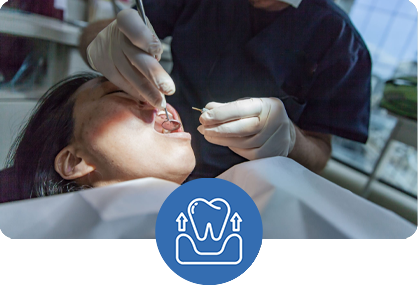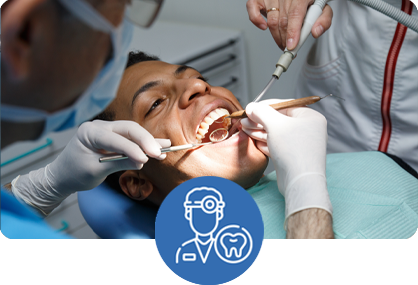When faced with a dental emergency, selecting an appropriate emergency dental care provider is essential. Whether experiencing severe dental pain, avulsed teeth, or other acute dental conditions, timely access to qualified care is crucial. This comprehensive guide outlines the critical considerations for selecting an emergency dentist capable of delivering high-quality care during urgent situations, ensuring optimal dental health outcomes even under challenging circumstances.
Dental Emergency Key Points
- Severe toothache often indicates decay or infection
- avulsed teeth require immediate professional care
- Fractured or chipped teeth can progress to more severe structural damage if left untreated
- Dislodged fillings or crowns need prompt replacement
- Swollen jaw or gums may signal serious infection
- Uncontrolled bleeding requires immediate attention
- Prompt treatment is crucial to prevent complications
- Many dental emergencies are preventable with proper oral care
- Regular dental check-ups can help avoid major interventions
- Emergency dentists often offer 24/7 availability
Understanding Dental Emergencies
Before addressing the selection criteria for emergency dental providers, it is essential to understand what constitutes a dental emergency. These conditions typically present with significant pain and may pose serious health risks if not promptly addressed. Common dental emergencies include:
- Severe toothache: Often indicative of advanced decay or infection, requiring immediate intervention to prevent progression.
- Avulsed tooth: Prompt professional intervention is critical, as timely treatment may enable successful reimplantation.
- Fractured of chipped tooth: While minor chips may not constitute emergencies, significant fractures can expose dental pulp, resulting in pain and infection risk.
- Dislodged fillings or crowns expose the underlying tooth structure, increasing the risk of decay, sensitivity, and structural deterioration
- Swollen jaw or gums: Edema may indicate a significant infection, such as an abscess, requiring urgent treatment to prevent systemic spread.
- Uncontrolled bleeding: Persistent oral hemorrhage following trauma or dental procedures necessitates immediate professional attention.
Recognition of these conditions and prompt action can significantly influence outcomes, potentially determining whether a tooth can be preserved or whether a localized issue progresses to a more serious health concern. The following sections outline critical considerations for selecting an appropriate emergency dental provider to ensure optimal management of these urgent conditions.
Key Factors in Selecting an Emergency Dentist
While the urgency of dental emergencies may create pressure to select the first available provider, thoughtful consideration of several factors can significantly impact the quality of care received and potentially improve clinical outcomes while optimizing cost-effectiveness:
1. Availability and Response Time
In dental emergencies, expedient intervention is paramount. Timely treatment is often directly correlated with positive outcomes. Optimal emergency dental providers offer:
- 24/7 emergency services: Dental emergencies frequently occur outside standard business hours, necessitating around-the-clock availability.
- Same-day appointments: The capacity to accommodate urgent cases promptly is essential for addressing acute dental conditions effectively.
- After-hours care: Evening and weekend availability ensures access to care when emergencies occur outside conventional office hours.
Timely intervention can be determinative in cases such as tooth avulsion, where prompt treatment may mean the difference between successful reimplantation and permanent tooth loss. Additionally, consider the practice’s triage protocols and how emergency cases are prioritized and scheduled.
2. Qualifications and Experience
When confronting a dental emergency, provider expertise and clinical experience are critical factors that can significantly influence treatment outcomes. Consider:
- Clinical experience in emergency dentistry: Extensive experience managing diverse dental emergencies typically correlates with improved outcomes and treatment efficiency.
- Specialized training in emergency procedures: Advanced training in emergency dental care may equip providers with enhanced capabilities for managing complex cases.
- Board certifications and continuing education: These credentials demonstrate commitment to maintaining current knowledge of emerging techniques and technologies in emergency dental care.
Professional qualifications should be readily verifiable. An established emergency dentist will transparently communicate their credentials, training history, and experience managing specific emergency conditions. Consider inquiring about the provider’s experience with particular procedures relevant to your emergency, such as reimplantation of avulsed teeth or management of severe odontogenic infections.
3. Range of Emergency Services
Dental emergencies encompass diverse conditions requiring varied interventions. Select a provider offering comprehensive emergency services to ensure appropriate management of various acute dental conditions:
Pain Management
Quick relief for bad toothaches
Tooth Extractions
Removing damaged or infected teeth
Root Canal Therapy
Treatment for severe tooth decay or infection
Dental Trauma Treatment
Care for chipped, broken, or knocked-out teeth
A comprehensive emergency service provider offers more timely and effective intervention, regardless of the presenting condition. This holistic approach ensures that patients with conditions ranging from pulpal infections requiring endodontic(root canal) therapy to traumatic injuries necessitating immediate restoration receive appropriate care without referral delays or extended waiting periods.
4. Location and Accessibility
Proximity to care is a significant consideration in dental emergencies. The stress associated with acute dental conditions can be exacerbated by lengthy or complex travel to receive treatment. Consider providers who are:
- Strategically located near residential or employment areas: Proximity can substantially reduce transit time and associated stress during emergencies.
- Accessible via public transportation when applicable: For individuals reliant on public transit, this accessibility can be crucial for timely care.
- Situated in secure locations, particularly for after-hours care: Choosing a clinic in a secure, accessible location ensures peace of mind during late or emergency visits.
Selecting a conveniently located emergency dental provider can minimize travel-related complications during an already challenging situation. Additional considerations include parking availability and facility accessibility, factors particularly significant during acute pain or distress.
5. Technology and Equipment
Contemporary dental technology facilitates more precise diagnostics, effective interventions, and enhanced patient comfort. In emergency situations, advanced equipment can be particularly valuable. Consider providers offering:
- Digital radiography for expedited and precise imaging: These systems provide immediate results with reduced radiation exposure compared to conventional radiographs.
- Enhanced sterilization protocols: Adhering to high standards of infection control is essential, especially during emergency treatments, to ensure patient safety and prevent complications.
- State-of-the-art emergency dental equipment: This may include instruments for minimally invasive procedures, advanced imaging technology, and efficient pain management systems.
These technological capabilities can enhance the emergency treatment experience while improving clinical outcomes. For instance, three-dimensional imaging provides enhanced visualization of dental structures, facilitating complex emergency procedures, while laser dentistry instruments may offer more precise and less invasive treatment options for specific emergency conditions.
Steps to Take When Choosing an Emergency Dentist
Having identified the essential criteria for emergency dental providers, the following step-by-step approach will facilitate selection of an appropriate practitioner, ideally implemented proactively before an emergency arises:
1. Research and Create a List
Begin by developing a comprehensive list of potential emergency dental providers in your vicinity. Conducting this research proactively can conserve valuable time during actual emergencies. Consider:
- Seeking recommendations from colleagues, family members, and friends: Personal testimonials can provide valuable insights regarding quality of care and service delivery.
- Conducting targeted online searches for emergency dental providers in your area: Utilize reputable dental directories and review platforms to identify highly-rated emergency practitioners in proximity to your location.
- Consulting with your primary dental provider regarding emergency care options or professional referrals: Your established dentist may offer emergency services or can recommend trusted colleagues who specialize in urgent dental care.
2. Verify Credentials and Read Reviews
Once potential providers have been identified, conduct thorough due diligence on each candidate:
- Examine professional websites for information regarding qualifications and emergency service offerings: Look for detailed information about educational background, certifications, and specific experience in emergency dental care.
- Review patient testimonials and ratings: Pay particular attention to comments addressing emergency care experiences, responsiveness, and treatment outcomes.
- Verify licensure status through state dental board registries: This verification ensures the provider maintains appropriate professional credentials and can reveal any disciplinary actions or formal complaints.
Patient experiences can offer valuable perspectives on service quality, particularly regarding high-acuity emergency situations. Identify patterns in reviews that demonstrate consistent quality of care and positive outcomes in emergency treatment scenarios.
3. Call and Ask Questions
Direct communication with prospective providers can yield significant insights regarding responsiveness and patient care philosophy. Consider inquiring about:
- Emergency protocols and procedures: Understand the established systems for managing after-hours emergencies and typical response timeframes.
- Average wait times for emergency appointments: Response times can vary substantially between providers and represent critical information for emergency planning.
- After-hours availability: Confirm the provision of genuine 24/7 emergency care if this capability is important to your needs.
- Insurance participation and financial policies: Emergency dental care can involve significant expenses, making financial considerations an important planning factor.
A reputable emergency dental practice will readily provide transparent information regarding their services and protocols. The quality of this communication often reflects the standard of care provided during actual emergencies.
4. Consider Insurance and Costs
Financial considerations are important aspects of emergency dental care planning. Proactive understanding of these factors can prevent financial complications during crisis situations:
- Verify insurance network participation: For those with dental insurance, confirming in-network status optimizes benefit utilization.
- Inquire about payment flexibility for emergency care: Some practices may provide structured options or collaborate with third-party services to help make treatment more manageable.
- Request estimated costs for common emergency procedures: While exact costs vary by case complexity, general cost parameters can facilitate financial planning.
Financial preparedness can mitigate stress during emergency situations and prevent treatment delays due to financial concerns. Some practices offer membership programs that include discounted emergency services, which may merit consideration for individuals at elevated risk for dental emergencies.
Preparing for a Dental Emergency
While dental emergencies cannot always be prevented, proactive preparation significantly enhances management capacity and potentially reduces resultant damage. The following preparatory measures are recommended:
1. Create an Emergency Dental Kit
Maintain a home emergency kit containing essential supplies that can facilitate interim management until professional care is available. Key components include:
Pain relievers
Over-the-counter pain medication to manage discomfort
Gauze and cotton swabs
For cleaning and controlling bleeding
Temporary filling material
To protect exposed tooth surfaces
These supplies can facilitate pain management and dental protection until professional intervention is available. Consider including additional items such as cold compresses for edema reduction. Familiarize yourself with basic dental first-aid techniques for common emergencies to enable appropriate initial response when needed.
2. Save Emergency Dentist Contacts
Store comprehensive contact information for your selected emergency dental provider in readily accessible formats and share this information with household members. Include:
- Provider name and primary office telephone number: Ensure immediate access for contact during regular business hours.
- After-hours emergency contact information: Many practices maintain separate communication channels for emergencies occurring outside standard hours.
- Practice location details for navigation purposes: During emergencies, efficient navigation to the provider’s location is essential.
What to Expect During an Emergency Dental Visit
Understanding the typical emergency dental visit process can alleviate anxiety and enhance preparedness for the experience. The standard emergency dental evaluation typically includes:
- Comprehensive assessment of the affected area: The practitioner will conduct a thorough examination to determine the extent of the condition, utilizing visual inspection and gentle palpation.
- Radiographic or other diagnostic imaging as indicated: These modalities help identify conditions not apparent through clinical examination, such as root fractures or periapical pathology.
- Treatment option consultation: The provider will present diagnostic findings and recommend appropriate intervention strategies.
- Immediate pain management measures: This may include local anesthesia, analgesic prescriptions, or other modalities to address acute discomfort.
- Definitive treatment for the underlying condition: Depending on the specific emergency, interventions may range from conservative restorative procedures to more complex therapies such as endodontic treatment or extraction.
Understanding these procedural expectations can enhance preparedness and reduce anxiety during the emergency dental visit, particularly when managing acute pain or infection related to the tooth’s pulp or surrounding structures. Emergency dental practitioners are specifically trained to manage high-acuity situations and will prioritize patient comfort throughout the treatment process.
Conclusion: Making the Right Choice for Your Dental Health
Selecting an appropriate emergency dental provider is a critical component of comprehensive oral healthcare planning. Through careful consideration of factors including availability, professional qualifications, service scope, geographic accessibility, and technological capabilities, patients can identify practitioners capable of delivering high-quality care during dental emergencies. The investment of time in researching and selecting an emergency dental provider proactively can yield significant benefits when urgent dental situations arise.
It is strongly recommended to establish an emergency dental care relationship before acute needs arise. Having a predetermined provider ensures immediate access to appropriate care when needed most. This proactive approach minimizes decision-making during crisis situations and potentially reduces both physical and psychological stress associated with dental emergencies.
By implementing the recommendations outlined in this guide, patients can make informed decisions regarding emergency dental care providers. Prompt and appropriate intervention during dental emergencies is instrumental in preserving oral health and function. Preparation, informed provider selection, and timely response represent the optimal approach to managing dental emergencies effectively and maintaining long-term oral health.

 718-979-2121
718-979-2121












